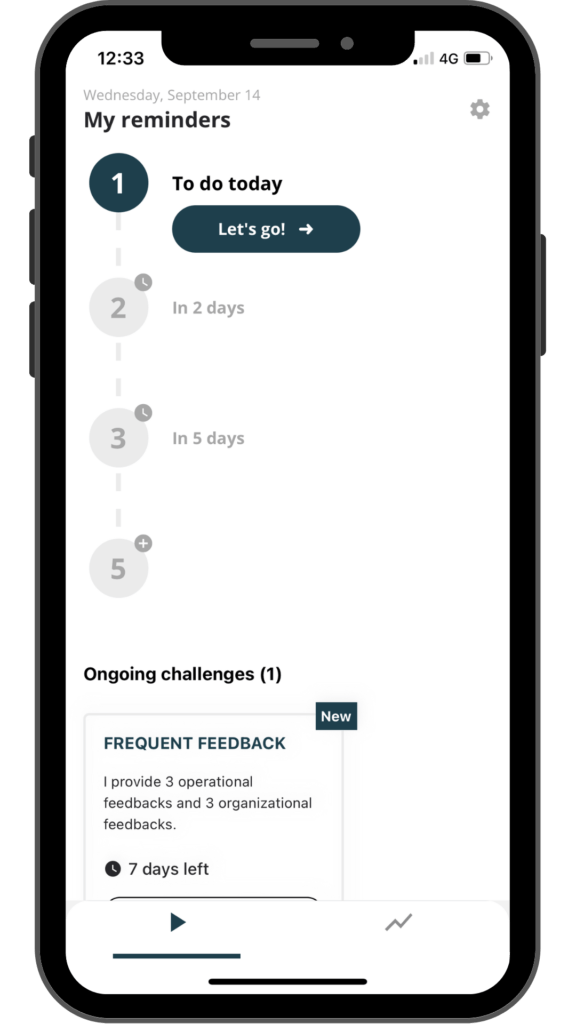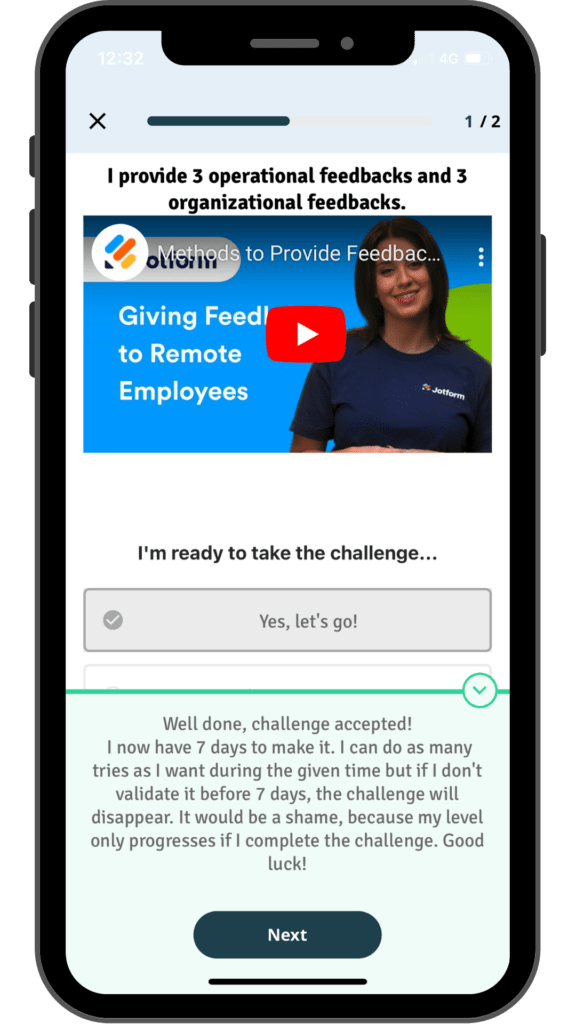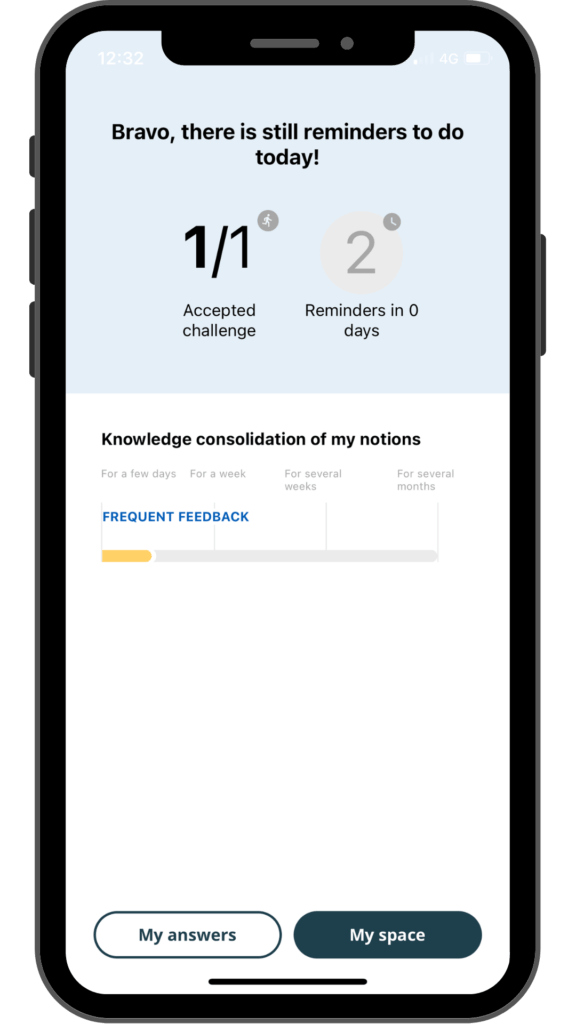New feature: reinforce your learners’ skills with Action Based Learning!
September is full of news! We’ve been telling you about it for a few weeks now, and it’s finally here. Enforced Action Based Learning has been introduced as a new feature in our Domoscio Lock reinforcement tool. Deployed during the summer, it is now available via the Lock mobile application and integrated in any LMS platform. This is the right time to tell you more about this innovative feature that you won’t be able to do without.
Domoscio Lock is a tool based on adaptive reinforcement which accompanies the employee with personalised reminders spaced out over time and which relate to the key knowledge and skills of his or her learning path. The aim is to reinforce knowledge efficiently over the long term.
1) Why use Enforced Action Based Learning?
Combining theory and practice is the challenge facing learning today. Are you familiar with the 70/20/10 model? This model states that learning time is divided up as follows: 10% of learning takes place during formal and traditional training (whether face-to-face or remote), 20% is built up through exchanges with colleagues and others. Finally 70%, i.e. the vast majority of learning, is through practice and experience. Learning is therefore rapidly turning 100% digital.
So, it’s certainly important to follow a traditional learning path to assimilate knowledge and skills. However, it’s not enough to be content with this: a skill will be truly acquired and reinforced when the learner applies it repeatedly. Unlike microlearning, which mainly deals with theoretical knowledge, enforced Action Based Learning enables skills to be developed through practice. How can we measure a learner’s skills and attitudes without assessing their application in professional life? This is difficult. Even the best immersive learning will not perfectly reflect the conditions of the corresponding professional situation. In order to know if a person is capable of doing it, you have to make them perform the action. And the best way to do this is to use micro-actions. Indeed, if the latter is well contextualised, it must fit perfectly into the learner’s daily life and take very little time.
Enforced Action Based Learning is therefore also known as ‘active learning’ (although they’re slightly different), and allows the application of technical and/or behavioural skills seen during upstream learning. Numerous studies have shown that structuring learning through action allows for better acquisition of skills. Ideally, the acquisition of knowledge should be alternated with the application of know-how.
2) What is Enforced Action Based Learning?
Enforced Action Based Learning takes the form of challenges in the learners’ working lives. These challenges should be achievable independently and in situations that the learner encounters regularly. These challenges should be achievable independently and in situations that the learner encounters regularly. For example, to anchor the competency “to facilitate a meeting”, the challenges could be: “in the next meeting I facilitate, I clearly communicate the next steps at the end of the session:
- “At the next meeting I facilitate, I clearly communicate the next steps at the end of the session”.
- “Before the next meeting I organise, I specify in the invitation the different topics to be discussed on the agenda.”
The learner will be challenged to complete these micro-actions with reminders spaced out over time. This will enable them to apply the relevant skills in their working lives. The repetition of these actions will help to reinforce the skills.
Once the challenge has been completed and passed, the learner will develop satisfaction in having applied the skills. He or she will then have the desire to continue to carry out more and more challenges since he or she will be an actor in his or her own development and will observe the positive impacts of enforced action based learning.
3) Enforced Action Based Learning, a new feature of Domoscio Lock
Enforced Action Based Learning is now available on the Domoscio Lock tool. Its deployment is accompanied by new features in the 3 existing roles on the platform: Designer role, Learner role and Supervisor role.
The Designer role – Thanks to the Micro-action, the designer has access to two forms of reinforced content: in addition to being able to create anchor questions dedicated to their learners, the designer can now create challenges. All they have to do is create a new challenge related to the technical or behavioural skill to be applied, with the possibility of adding media content (photo, video). A theme can be created with only questions, only challenges, or a combination of both. The designer must, beforehand, clearly identify the professional situation in order to create the corresponding challenges.
The Learner role -The learner continues to receive reminders via their LMS or in the form of push notifications on their smartphone. But this time, the reminders can be in the form of a challenge. The learner has the choice between “I am ready to take the challenge” or “I am not ready”. If the learner is not ready and does not think they have the skill to do it, another challenge using the same skill will be offered later. If not, the learner has 7 days to complete it (the estimated time for the work situation to arise). Once the challenge has been completed, the learner shares feedback on which the Domoscio algorithm bases itself in order to propose other challenges in line with the learner’s needs.



The Supervisor role – the supervisor has access to all the feedback from completed challenges. This allows the supervisor to identify learners who have had difficulties in completing the challenge. Subsequently, the supervisor can implement specific training actions with the employees in order to understand the difficulties encountered.
Do you have any questions about enforced Action Based Learning? Would you like a demonstration of Domoscio Lock with this new feature? Then contact us! We will be happy to give you a more detailed presentation of the Micro-action.
Latest news
Our latest articles about the topics: learning, science and Domoscio's news.